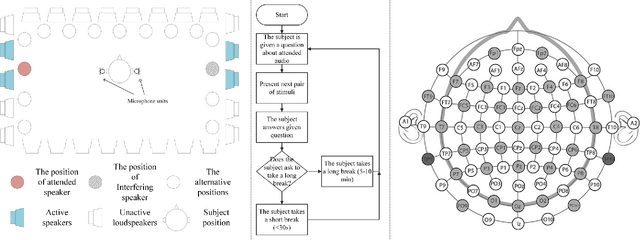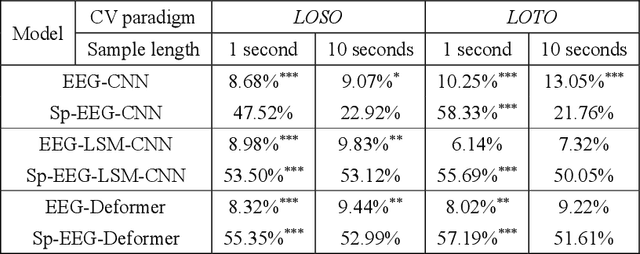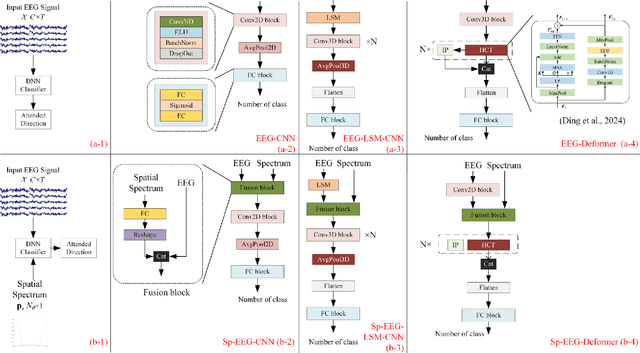Fei Chen
CUHK
ManiDP: Manipulability-Aware Diffusion Policy for Posture-Dependent Bimanual Manipulation
Oct 27, 2025Abstract:Recent work has demonstrated the potential of diffusion models in robot bimanual skill learning. However, existing methods ignore the learning of posture-dependent task features, which are crucial for adapting dual-arm configurations to meet specific force and velocity requirements in dexterous bimanual manipulation. To address this limitation, we propose Manipulability-Aware Diffusion Policy (ManiDP), a novel imitation learning method that not only generates plausible bimanual trajectories, but also optimizes dual-arm configurations to better satisfy posture-dependent task requirements. ManiDP achieves this by extracting bimanual manipulability from expert demonstrations and encoding the encapsulated posture features using Riemannian-based probabilistic models. These encoded posture features are then incorporated into a conditional diffusion process to guide the generation of task-compatible bimanual motion sequences. We evaluate ManiDP on six real-world bimanual tasks, where the experimental results demonstrate a 39.33$\%$ increase in average manipulation success rate and a 0.45 improvement in task compatibility compared to baseline methods. This work highlights the importance of integrating posture-relevant robotic priors into bimanual skill diffusion to enable human-like adaptability and dexterity.
Auditory Attention Decoding from Ear-EEG Signals: A Dataset with Dynamic Attention Switching and Rigorous Cross-Validation
Oct 22, 2025Abstract:Recent promising results in auditory attention decoding (AAD) using scalp electroencephalography (EEG) have motivated the exploration of cEEGrid, a flexible and portable ear-EEG system. While prior cEEGrid-based studies have confirmed the feasibility of AAD, they often neglect the dynamic nature of attentional states in real-world contexts. To address this gap, a novel cEEGrid dataset featuring three concurrent speakers distributed across three of five distinct spatial locations is introduced. The novel dataset is designed to probe attentional tracking and switching in realistic scenarios. Nested leave-one-out validation-an approach more rigorous than conventional single-loop leave-one-out validation-is employed to reduce biases stemming from EEG's intricate temporal dynamics. Four rule-based models are evaluated: Wiener filter (WF), canonical component analysis (CCA), common spatial pattern (CSP) and Riemannian Geometry-based classifier (RGC). With a 30-second decision window, WF and CCA models achieve decoding accuracies of 41.5% and 41.4%, respectively, while CSP and RGC models yield 37.8% and 37.6% accuracies using a 10-second window. Notably, both WF and CCA successfully track attentional state switches across all experimental tasks. Additionally, higher decoding accuracies are observed for electrodes positioned at the upper cEEGrid layout and near the listener's right ear. These findings underscore the utility of dynamic, ecologically valid paradigms and rigorous validation in advancing AAD research with cEEGrid.
Extremum Flow Matching for Offline Goal Conditioned Reinforcement Learning
May 26, 2025Abstract:Imitation learning is a promising approach for enabling generalist capabilities in humanoid robots, but its scaling is fundamentally constrained by the scarcity of high-quality expert demonstrations. This limitation can be mitigated by leveraging suboptimal, open-ended play data, often easier to collect and offering greater diversity. This work builds upon recent advances in generative modeling, specifically Flow Matching, an alternative to Diffusion models. We introduce a method for estimating the extremum of the learned distribution by leveraging the unique properties of Flow Matching, namely, deterministic transport and support for arbitrary source distributions. We apply this method to develop several goal-conditioned imitation and reinforcement learning algorithms based on Flow Matching, where policies are conditioned on both current and goal observations. We explore and compare different architectural configurations by combining core components, such as critic, planner, actor, or world model, in various ways. We evaluated our agents on the OGBench benchmark and analyzed how different demonstration behaviors during data collection affect performance in a 2D non-prehensile pushing task. Furthermore, we validated our approach on real hardware by deploying it on the Talos humanoid robot to perform complex manipulation tasks based on high-dimensional image observations, featuring a sequence of pick-and-place and articulated object manipulation in a realistic kitchen environment. Experimental videos and code are available at: https://hucebot.github.io/extremum_flow_matching_website/
Hunyuan-TurboS: Advancing Large Language Models through Mamba-Transformer Synergy and Adaptive Chain-of-Thought
May 21, 2025Abstract:As Large Language Models (LLMs) rapidly advance, we introduce Hunyuan-TurboS, a novel large hybrid Transformer-Mamba Mixture of Experts (MoE) model. It synergistically combines Mamba's long-sequence processing efficiency with Transformer's superior contextual understanding. Hunyuan-TurboS features an adaptive long-short chain-of-thought (CoT) mechanism, dynamically switching between rapid responses for simple queries and deep "thinking" modes for complex problems, optimizing computational resources. Architecturally, this 56B activated (560B total) parameter model employs 128 layers (Mamba2, Attention, FFN) with an innovative AMF/MF block pattern. Faster Mamba2 ensures linear complexity, Grouped-Query Attention minimizes KV cache, and FFNs use an MoE structure. Pre-trained on 16T high-quality tokens, it supports a 256K context length and is the first industry-deployed large-scale Mamba model. Our comprehensive post-training strategy enhances capabilities via Supervised Fine-Tuning (3M instructions), a novel Adaptive Long-short CoT Fusion method, Multi-round Deliberation Learning for iterative improvement, and a two-stage Large-scale Reinforcement Learning process targeting STEM and general instruction-following. Evaluations show strong performance: overall top 7 rank on LMSYS Chatbot Arena with a score of 1356, outperforming leading models like Gemini-2.0-Flash-001 (1352) and o4-mini-2025-04-16 (1345). TurboS also achieves an average of 77.9% across 23 automated benchmarks. Hunyuan-TurboS balances high performance and efficiency, offering substantial capabilities at lower inference costs than many reasoning models, establishing a new paradigm for efficient large-scale pre-trained models.
DynamiCtrl: Rethinking the Basic Structure and the Role of Text for High-quality Human Image Animation
Mar 27, 2025Abstract:Human image animation has recently gained significant attention due to advancements in generative models. However, existing methods still face two major challenges: (1) architectural limitations, most models rely on U-Net, which underperforms compared to the MM-DiT; and (2) the neglect of textual information, which can enhance controllability. In this work, we introduce DynamiCtrl, a novel framework that not only explores different pose-guided control structures in MM-DiT, but also reemphasizes the crucial role of text in this task. Specifically, we employ a Shared VAE encoder for both reference images and driving pose videos, eliminating the need for an additional pose encoder and simplifying the overall framework. To incorporate pose features into the full attention blocks, we propose Pose-adaptive Layer Norm (PadaLN), which utilizes adaptive layer normalization to encode sparse pose features. The encoded features are directly added to the visual input, preserving the spatiotemporal consistency of the backbone while effectively introducing pose control into MM-DiT. Furthermore, within the full attention mechanism, we align textual and visual features to enhance controllability. By leveraging text, we not only enable fine-grained control over the generated content, but also, for the first time, achieve simultaneous control over both background and motion. Experimental results verify the superiority of DynamiCtrl on benchmark datasets, demonstrating its strong identity preservation, heterogeneous character driving, background controllability, and high-quality synthesis. The project page is available at https://gulucaptain.github.io/DynamiCtrl/.
Muscle Activation Estimation by Optimizing the Musculoskeletal Model for Personalized Strength and Conditioning Training
Feb 20, 2025



Abstract:Musculoskeletal models are pivotal in the domains of rehabilitation and resistance training to analyze muscle conditions. However, individual variability in musculoskeletal parameters and the immeasurability of some internal biomechanical variables pose significant obstacles to accurate personalized modelling. Furthermore, muscle activation estimation can be challenging due to the inherent redundancy of the musculoskeletal system, where multiple muscles drive a single joint. This study develops a whole-body musculoskeletal model for strength and conditioning training and calibrates relevant muscle parameters with an electromyography-based optimization method. By utilizing the personalized musculoskeletal model, muscle activation can be subsequently estimated to analyze the performance of exercises. Bench press and deadlift are chosen for experimental verification to affirm the efficacy of this approach.
Human-Like Robot Impedance Regulation Skill Learning from Human-Human Demonstrations
Feb 19, 2025Abstract:Humans are experts in collaborating with others physically by regulating compliance behaviors based on the perception of their partner states and the task requirements. Enabling robots to develop proficiency in human collaboration skills can facilitate more efficient human-robot collaboration (HRC). This paper introduces an innovative impedance regulation skill learning framework for achieving HRC in multiple physical collaborative tasks. The framework is designed to adjust the robot compliance to the human partner states while adhering to reference trajectories provided by human-human demonstrations. Specifically, electromyography (EMG) signals from human muscles are collected and analyzed to extract limb impedance, representing compliance behaviors during demonstrations. Human endpoint motions are captured and represented using a probabilistic learning method to create reference trajectories and corresponding impedance profiles. Meanwhile, an LSTMbased module is implemented to develop task-oriented impedance regulation policies by mapping the muscle synergistic contributions between two demonstrators. Finally, we propose a wholebody impedance controller for a human-like robot, coordinating joint outputs to achieve the desired impedance and reference trajectory during task execution. Experimental validation was conducted through a collaborative transportation task and two interactive Tai Chi pushing hands tasks, demonstrating superior performance from the perspective of interactive forces compared to a constant impedance control method.
LP-ICP: General Localizability-Aware Point Cloud Registration for Robust Localization in Extreme Unstructured Environments
Jan 05, 2025



Abstract:The Iterative Closest Point (ICP) algorithm is a crucial component of LiDAR-based SLAM algorithms. However, its performance can be negatively affected in unstructured environments that lack features and geometric structures, leading to low accuracy and poor robustness in localization and mapping. It is known that degeneracy caused by the lack of geometric constraints can lead to errors in 6-DOF pose estimation along ill-conditioned directions. Therefore, there is a need for a broader and more fine-grained degeneracy detection and handling method. This paper proposes a new point cloud registration framework, LP-ICP, that combines point-to-line and point-to-plane distance metrics in the ICP algorithm, with localizability detection and handling. LP-ICP consists of a localizability detection module and an optimization module. The localizability detection module performs localizability analysis by utilizing the correspondences between edge points (with low local smoothness) to lines and planar points (with high local smoothness) to planes between the scan and the map. The localizability contribution of individual correspondence constraints can be applied to a broader range. The optimization module adds additional soft and hard constraints to the optimization equations based on the localizability category. This allows the pose to be constrained along ill-conditioned directions, with updates either tending towards the constraint value or leaving the initial estimate unchanged. This improves accuracy and reduces fluctuations. The proposed method is extensively evaluated through experiments on both simulation and real-world datasets, demonstrating higher or comparable accuracy than the state-of-the-art methods. The dataset and code of this paper will also be open-sourced at https://github.com/xuqingyuan2000/LP-ICP.
Human-Humanoid Robots Cross-Embodiment Behavior-Skill Transfer Using Decomposed Adversarial Learning from Demonstration
Dec 19, 2024Abstract:Humanoid robots are envisioned as embodied intelligent agents capable of performing a wide range of human-level loco-manipulation tasks, particularly in scenarios requiring strenuous and repetitive labor. However, learning these skills is challenging due to the high degrees of freedom of humanoid robots, and collecting sufficient training data for humanoid is a laborious process. Given the rapid introduction of new humanoid platforms, a cross-embodiment framework that allows generalizable skill transfer is becoming increasingly critical. To address this, we propose a transferable framework that reduces the data bottleneck by using a unified digital human model as a common prototype and bypassing the need for re-training on every new robot platform. The model learns behavior primitives from human demonstrations through adversarial imitation, and the complex robot structures are decomposed into functional components, each trained independently and dynamically coordinated. Task generalization is achieved through a human-object interaction graph, and skills are transferred to different robots via embodiment-specific kinematic motion retargeting and dynamic fine-tuning. Our framework is validated on five humanoid robots with diverse configurations, demonstrating stable loco-manipulation and highlighting its effectiveness in reducing data requirements and increasing the efficiency of skill transfer across platforms.
Electroencephalogram-based Multi-class Decoding of Attended Speakers' Direction with Audio Spatial Spectrum
Nov 11, 2024



Abstract:Decoding the directional focus of an attended speaker from listeners' electroencephalogram (EEG) signals is essential for developing brain-computer interfaces to improve the quality of life for individuals with hearing impairment. Previous works have concentrated on binary directional focus decoding, i.e., determining whether the attended speaker is on the left or right side of the listener. However, a more precise decoding of the exact direction of the attended speaker is necessary for effective speech processing. Additionally, audio spatial information has not been effectively leveraged, resulting in suboptimal decoding results. In this paper, we observe that, on our recently presented dataset with 15-class directional focus, models relying exclusively on EEG inputs exhibits significantly lower accuracy when decoding the directional focus in both leave-one-subject-out and leave-one-trial-out scenarios. By integrating audio spatial spectra with EEG features, the decoding accuracy can be effectively improved. We employ the CNN, LSM-CNN, and EEG-Deformer models to decode the directional focus from listeners' EEG signals with the auxiliary audio spatial spectra. The proposed Sp-Aux-Deformer model achieves notable 15-class decoding accuracies of 57.48% and 61.83% in leave-one-subject-out and leave-one-trial-out scenarios, respectively.
 Add to Chrome
Add to Chrome Add to Firefox
Add to Firefox Add to Edge
Add to Edge